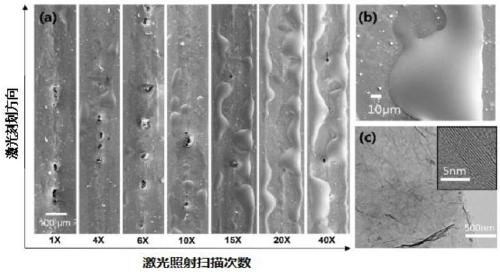Method for preparing graphene sensor on composite material surface
A composite material and graphene technology, applied in the field of sensors, can solve the problems of lack of graphene sensors, many preparation steps, high cost, etc., and achieve the effect of low cost, simple preparation method and few steps
- Summary
- Abstract
- Description
- Claims
- Application Information
AI Technical Summary
Problems solved by technology
Method used
Image
Examples
Embodiment 1
[0067] (1) The raw material is glass fiber / epoxy resin prepreg, which is prepared into a flat composite material board at 140°C by vacuum bagging process, with a thickness of 5mm and an area of 200mm×200mm.
[0068] (2) Disperse 300 mg of graphene oxide in 100 ml of deionized aqueous solution, and use an ultrasonic processor to disperse for 1 hour at a power of 480 W to obtain a uniform dispersion of graphene oxide. Using the X-Y-Z three-axis platform controlled by the motor, the composite material plate is kept heated at 100°C and assembled on the platform to ensure that the water in the solution can evaporate immediately when the graphene oxide dispersion is sprayed on the composite material. Put the graphene oxide solution in the airbrush and assemble the airbrush on the platform, adjust the air pressure of the airbrush to 5PSI, and prepare a graphene oxide film on the composite material plate with a thickness of 5 μm.
[0069] (3) Use a diode laser with a wavelength of 7...
Embodiment 2
[0076] Other steps are the same as in Example 1, the only difference is that the laser irradiation focusing multiples in step (3) are 5 times focusing and 50 times focusing respectively, and the scanning times are 50 times and 20 times respectively.
[0077] Test the resistance change of the graphene sensor element under different laser irradiation focusing multiples, the obtained results are as follows Figure 5 as shown, Figure 5 is the sheet resistance data of the graphene sensor element under laser 5x focus and 50x focus; according to Figure 5 It can be seen that as the number of laser irradiation increases, the sheet resistance becomes smaller and smaller, indicating that the reduction degree of graphene oxide is getting higher and higher, and the conductivity is getting better and better.
Embodiment 3
[0079] Measuring the resistance change of graphene sensors when the composite material undergoes tensile deformation
[0080] (1) The other steps are the same as in Example 1, except that the number of scanning times of laser irradiation in step (3) is 6.
[0081] Make the composite material undergo different degrees of cyclic tensile deformation (0.2%, 0.4% and 0.6%), and detect the relative change of the resistance of the graphene sensor. The obtained results are as follows Figure 6 shown, according to Figure 6 It can be seen that the relative change in resistance of the graphene sensor is in good agreement with the tensile deformation during each test cycle, and the greater the mechanical strain, the greater the change in resistance.
[0082] (2) The other steps are the same as in Example 1, except that the number of laser irradiation scans in step (3) is 4 times, 6 times, 8 times, 10 times and 40 times respectively.
[0083] The maximum strain level of the composite ma...
PUM
| Property | Measurement | Unit |
|---|---|---|
| concentration | aaaaa | aaaaa |
| thickness | aaaaa | aaaaa |
| wavelength | aaaaa | aaaaa |
Abstract
Description
Claims
Application Information
 Login to View More
Login to View More - R&D
- Intellectual Property
- Life Sciences
- Materials
- Tech Scout
- Unparalleled Data Quality
- Higher Quality Content
- 60% Fewer Hallucinations
Browse by: Latest US Patents, China's latest patents, Technical Efficacy Thesaurus, Application Domain, Technology Topic, Popular Technical Reports.
© 2025 PatSnap. All rights reserved.Legal|Privacy policy|Modern Slavery Act Transparency Statement|Sitemap|About US| Contact US: help@patsnap.com



